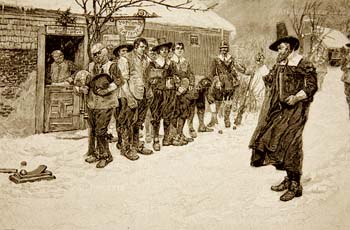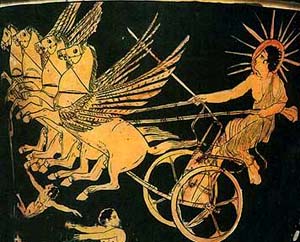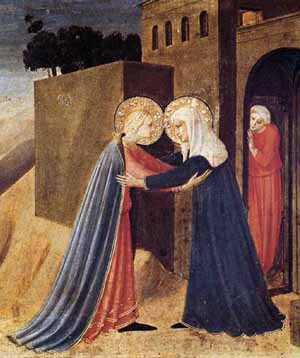 |
Faith under Attack
Christmas Was Never a Pagan Holiday
Marian T. Horvat, Ph.D..
Around this time of year we are bombarded with anti-Catholic propaganda questioning the blessed day of Christ’s birth as December 25. This date, we arrogantly are told, was originally a pagan holiday. The Early Church “chose” it to “Christianize” a Roman feast of the Sun. According to this theory, the Christmas date was only established in the 4th century, when we have the first evidence of the Nativity being celebrated in Rome in 336. The conclusion: The origins of Christmas are pagan, and we do not really know the date the Savior of mankind was born.
Let us not be too quickly impressed with these lies whose aim is solely to diminish the homage we pay Our Lord Jesus Christ and to denigrate the Catholic Church. In fact, the opposite is true. It is the thesis of the pagan origins of Christmas that is a myth without historical substance.
No ancient Roman festivals on December 25
The notion that Christmas had pagan origins began to spread in the 17th century with the English Puritans and Scottish Presbyterians, who hated all Catholic things. The Puritans hated Catholicism so much that they revolted against the so-called Anglican church because, even with their heresies, they considered it still too similar to the Catholic Church.

A colonial Puritan governor stops the merrymaking of Christmas festivities (1883) |
They abhorred the feast days and in particular, they detested the Christmas feast with its joyous ceremonies, celebrations and customs. Since the Bible gave no specific date of Christ’s birth, the Puritans argued that it was a sinful contrivance of the Roman Catholic Church that should be abolished.
Later, Protestant preachers like the German Paul Ernst Jablonski tried to demonstrate in pseudo-scholarly works that December 25 was actually a pagan Roman feast, and that Christmas was yet another instance of how the medieval Catholic Church ‘paganized’ and corrupted ‘pure’ early Christianity. (1)
Around the same time, the Jesuit Jean Hardouin with his eccentric theory of universal forgery that put in doubt every historical source known, backed the Puritans on their theory of Christmas having pagan origins. But his research was largely discredited given his absurd affirmations. For example, he maintained all the Church Councils that took place before Trent were fictitious and almost all the classical texts of ancient Greece and Rome were false, made by monks in the 13th century. Such assertions are blatantly absurd, given the countless source documents demonstrating the opposite.
The two principal claims for Christmas having pagan origins pretend that the early Church chose December 25 in order to divert Catholics from Roman pagan festival days. The first claim pretends that it replaced the ancient Roman holiday of Saturnalia, a time of feasting and raucous merry-making held in December in honor of the pagan god Saturn.
Now, the Saturnalia festival always ended on December 23 at the latest. Why would the Catholic Church, to diverge the attention of her faithful from a pagan celebration, choose a date two days after that party had already ended and whoever wanted had already overindulged? It makes no sense. No serious scholar believes this claim.
Christmas established before the pagan Sun festival
The second claim is that the Catholic Church established Christmas on December 25 to replace a solar feast invented by Emperor Aurelian in 274 AD, the Dies Natalis Solis Invicti (Birth of the Unconquered Sun).
The fact that Christmas entered the world calendar (the accepted Roman calendar) in 354 – which was after the establishment of the pagan feast – does not necessarily mean the Church chose that day to replace the pagan holiday. Two principal reasons concur with this conclusion:

Aurelian instituted the sun festival to bolster a dying Roman Empire |
First, one must not simply assume that the early Christians only began to celebrate Christmas in the 4th century. Until the Edict of Milan was published in 313, Catholics were persecuted and met in catacombs. Hence, there was no public festivity. But they celebrated Christmas among themselves before that Edict, as hymns and prayers of the first Christians confirm (2).
Second, this claim is based on unsound assumptions. As scholar Thomas Talley points out in his book The Origins of the Liturgical Year, Emperor Aurelian inaugurated the festival of the Birth of the Unconquered Sun trying to give new life – a rebirth – to a dying Roman Empire. It is much more likely, he argues, that the Emperor’s action was a response to the growing popularity and strength of the Catholic religion, which was celebrating Christ’s birth on December 25, rather than the other way around. (3)
There is no evidence that Aurelian’s celebration preceded the feast of Christmas, and more reason to believe that establishing this festival day – which never won popular support and soon died out – was an effort to give a pagan significance to a date already of importance to Roman Catholics.
Dates based on the Scriptures
But let us leave the realm of conjecture and return to historical records. There is ample evidence to demonstrate that, even though the Christmas date was not made official until 354, clearly it was established long before Aurelian instituted his pagan feastday.
The conception of St. John the Baptist is the historical anchor to know the date of Christmas, based on the detailed and careful calculations on dates made by first Fathers of the Church.

The date of St. Elizabeth's conception sets the base for knowing Christ's birth |
The early tractatus De solstitiia records the tradition of the Archangel Gabriel appearing to Zachariah in the High Temple when he was serving as high priest on the Day of Atonement (Lk 1:8). This placed the conception of St. John the Baptist during the feast of Tabernacles in late September, as the Archangel Gabriel said (Lk 1:28) and his birth nine months later at the time of the summer solstice. (4)
Since the Gospel of Luke states that the Archangel Gabriel appeared to the Virgin Mary in the sixth month after John's conception (Lk 1:26), this placed the conception of Christ at about the time of the spring equinox, that is, at the time of the Jewish Passover, in late March. His birth would
thus be in late December at the time of the winter solstice.
That these dates, based on Tradition and Scripture, are trustworthy is confirmed by recent evidence taken from the Dead Sea Scrolls, whose authors were very concerned about calendar dates, essential for establishing when the Torah feasts should be celebrated. The data found in the Scrolls make it possible to know the Temple’s rotating assignment of priests during Old Testament times and show definitely that Zachariah served as a Temple priest in September, thus confirming the tradition of the Early Church. (5)
The Catholic Church determined March 25 as the date of Our Lord’s Conception long before Aurelian decided to make his solar feast. For example, around 221 AD, Sexto Julio Africano wrote the Chronographiai in which he affirmed that the Annunciation was March 25. (6) Once the date of the Incarnation was established, it was a simple matter of adding nine months to arrive at the date of Our Lord’s birth - December 25. This date would not be made official until the late fourth century, but it was established long before Aurelian and Constantine. It had nothing to do with pagan festivals.
We can be certain that the first Catholic apologists and Fathers of the Church, who lived very close to the time of the Apostles, were fully aware of the dates associated with the birth of Our Lord Jesus Christ. They had all the calendar sources at hand and they would not allow any untruth to be introduced in the Catholic liturgy. The date of Christ’s birth was transmitted by them as being December 25, a Sunday.
Addressing the verse of Luke 2:7, Fr Cornelius a Lapide comments on the architecture of this choice: “Christ was born Sunday, because this was the first day of the world. … Christ was born on Sunday night, in keeping with the order of His marvels, so that the day on which He said Let there be light, and there was light, was the same day on which, at night, the light shone in darkness for the upright of heart, that is, the sun of justice, Christ the Lord.” (7)
1. Thomas Talley, The Origins of the Liturgical Year, Collegeville, MN: Liturgical Press, 1991), p. 88.
2 Daniel-Rops, Prières des Premiers Chrétiens, Paris: Fayard, 1952, pp. 125-127, 228-229
3. Talley, The Origins of the Liturgical Year, pp. 88-91.
4. The tract is entitled 'De solstitiia et aequinoctia conceptionis et nativitatis domini nostri iesu Christi et iohannis baptista,' in Ibid., p. 93-94. Talley also provides other historical documents of early Church writers showing that the dates of the Conception and Death of Our Lord had been established very early.
5. Shemaryahu Talmon, Professor Emeritus at Hebrew University in Jerusalem and a top Scroll scholar, published an in-depth study of the Temple’s rotating assignment of priests in 1958 and the Qumran scrolls to see the assignment during New Testament times. Martin K Barrack, “It Comes from Pagans,” Second Exodus online
6. Ibid.
7. Cornelius a Lapide, Commentaria in Scripturam Sanctam, Paris: Vives 1877, Luke 2:7, vol 16, p. 57.

Posted on December 15, 2010

Related Articles of Interest
 Ara Coeli: The Altar of the Heavens for
the Santo Bambino Ara Coeli: The Altar of the Heavens for
the Santo Bambino
 Don't Watch this Protestant
Nativity Story Don't Watch this Protestant
Nativity Story
 The Glorification of
Christmas through History The Glorification of
Christmas through History
 The Night of Christmas The Night of Christmas
 The Shepherd's Prayer The Shepherd's Prayer
 The Venerability of St.
Joseph The Venerability of St.
Joseph
 The Fullness of Time The Fullness of Time

Related Works of Interest
|
|
Faith under Attack | Religious | Home | Books | CDs | Search | Contact Us | Donate

© 2002-
Tradition in Action, Inc. All Rights Reserved
|
 |
|